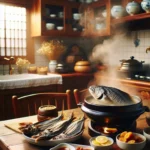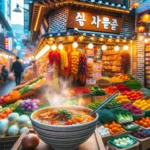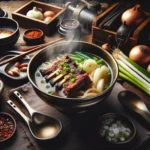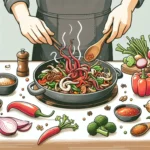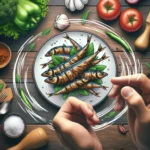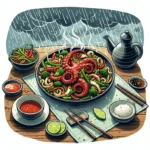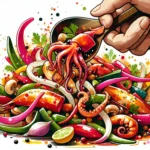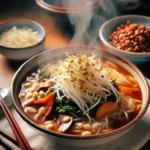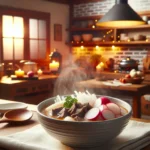In the heart of Korean cuisine, the remarkable Agui Tang awaits to enchant your senses. This monkfish stew, rich with flavors and history, invites you to embark on a culinary adventure. Imagine the delicate texture of monkfish mingling with aromatic spices, creating a dish that is wholesome and deeply satisfying. As we delve into the key ingredients and step-by-step cooking instructions, prepare to uncover tips that will elevate your stew to perfection. With serving suggestions and pairing ideas, your dining experience will transform into an unforgettable feast. Let’s dive in and discover the magic of this delicious Korean monkfish stew together!
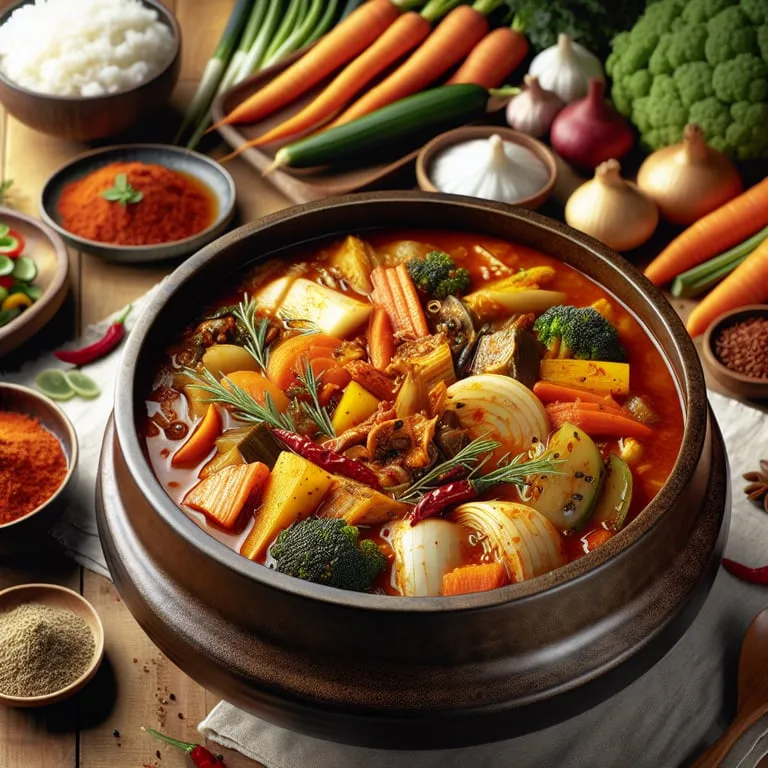
Key Ingredients for Authentic Agui Tang
To truly capture the essence of Authentic Agui Tang, one must carefully select each ingredient, as they play a pivotal role in balancing flavors and creating that mouthwatering experience that is so revered in Korean cuisine. ✨
Let’s dive into the essential components, shall we? First and foremost, the star of the dish is the monkfish, or “agui” in Korean. This sturdy fish, known for its delicate flavor yet firm texture, has a slightly sweet undertone. It holds up beautifully in stews, making it the perfect candidate for this hearty dish. Ideally, you’d want about 500 to 700 grams of monkfish fillets to serve around 4 people. The fresher, the better! 🐟
Next up, we can’t ignore the importance of a robust base. A traditional Agui Tang requires a rich broth, often beginning with making a hearty anchovy stock. To create this base, gather about 30-40 dried anchovies, removing their heads to minimize bitterness. Combine those with a piece of kelp (about 10cm), and simmer in 1.5 liters of water for around 20 minutes. This umami-infused stock elevates the broth to new heights! 🌊
Moreover, the addition of quality vegetable stock can enhance the flavors tremendously. Ingredients like onions (1 medium-sized), garlic (5-6 cloves), and green onions (2 stalks) will provide a sweet and aromatic backdrop. It’s the onion that brings a subtle sweetness, while the garlic adds depth.
In addition, don’t forget the spices! A blend of gochugaru (Korean red pepper flakes) – about 2 tablespoons – will infuse a wonderful heat; adjust according to your preference! This fiery component harmonizes with the fish, creating a marriage of flavors that is simply divine! You can also experiment with a splash of gochujang (Korean red chili paste), about 1 tablespoon, for an additional layer of flavor. 🌶️🔥
Additional Ingredients for Depth
For further authenticity, including some daikon radish (200 grams) is highly recommended. This veggie adds a crisp texture and absorbs the delightful flavors of the broth. Thinly slice it before adding to the stew for optimal results! 🚀
Seafood lovers rejoice! Incorporating some clams or mussels (about 200 grams) is a wonderful touch that amplifies the oceanic essence of this dish. The briny notes from the clams complement the monkfish, bringing a delightful complexity to the stew. 🦪
Lastly, garnish your Agui Tang with fresh herbs, such as perilla leaves or additional green onions, to provide that finishing touch. Not only do these herbs add a pop of color, but they also introduce aromatic flavors that elevate the complete dish. 🌿
With these key ingredients laid out, crafting an Authentic Agui Tang will be a delightful adventure! Each component harmonizes beautifully, thus creating a bowl of warmth and rich flavors that is perfect for any gathering or simply to indulge yourself on a cozy day in. The combination of textures and flavors will surely leave a lasting impression, making everyone savor each spoonful! 🍲❤️
Step-by-Step Cooking Instructions
To create an authentic Agui Tang that will not only please your taste buds but also warm your soul, follow these meticulously detailed steps. Cooking agui tang is an art that requires precision and patience, but the rewards are absolutely worth it! 🍲✨
1. Preparing the Monkfish
Start with a pound (approximately 450 grams) of fresh monkfish fillets. Rinse them gently under cold water and pat them dry with paper towels. Monkfish, known for its firm texture and mild flavor, is the star of this dish! Cut the fillets into bite-sized pieces, about 1 to 2 inches. This will ensure they cook evenly and absorb the flavorful broth. Did you know that monkfish is often dubbed “poor man’s lobster”? It’s a delicious and budget-friendly option! 🐟
2. Gathering the Vegetables
Chop your vegetables! You will need:
- 1 medium onion, sliced
- 2-3 cloves of garlic, minced
- 1-2 green chilies, sliced (adjust according to your spice tolerance, of course! 🌶️)
- 2 medium-sized potatoes, diced (about 1-inch cubes)
- 1 cup of daikon radish, thinly sliced
These vegetables will not only add immense flavor to your agui tang but also contribute to its fantastic texture!
3. Making the Broth
In a large pot, combine 5 cups of water and bring it to a boil. Once boiling, add the sliced onion, garlic, and daikon radish. Reduce the heat to a simmer and cook for about 10 minutes. This step creates a fragrant base for your stew, expanding its depth of flavor as the veggies release their natural oils! 🌿
4. Adding Flavor
Now comes the exciting part – season your broth! Add 2 tablespoons of Korean gochugaru (red pepper flakes) for spice, 1 tablespoon of gochujang (Korean chili paste) for that deep, savory kick, and 1 tablespoon of soy sauce for umami goodness. Stir well to combine, and let it simmer for another 5 minutes. The aroma must be tantalizing by now, right? 😍
5. Incorporating the Monkfish
It’s time to introduce your monkfish into the pot! Gently place the pieces of monkfish into the broth, alongside the chopped potatoes and green chilies. Cover the pot and let it simmer for approximately 15-20 minutes on medium heat. This allows the flavors to meld beautifully while the fish cooks to perfection. Keep an eye on it – you want the fish to be tender but not overcooked!
6. Final Seasoning Touches
After 20 minutes, taste your agui tang! Adjust the seasonings, adding salt or an extra splash of soy sauce to suit your palate. If you like a touch of sweetness, consider adding a teaspoon or two of sugar to balance out the flavors. Your taste buds will be grateful!
7. Garnishing and Serving
Once the monkfish is flaky and the potatoes are fork-tender, it’s time to serve! Remove the pot from heat and let it sit for a couple of minutes while you prepare your garnishes. Chopped green onions and a sprinkle of sesame seeds add a delightful finish to the dish, not to mention an inviting visual appeal! 🎉🌱
8. Accompanying Sides
Serve your agui tang hot, accompanied by a bowl of steamed white rice. The rice will soak up the spicy, savory broth wonderfully, and as a sidekick, consider some kimchi for that perfect Korean dining experience!
Each step in making agui tang is simple yet profound, allowing you to enjoy the journey of cooking! The ingredients blend together seamlessly, creating a harmonious, heartwarming stew that speaks of tradition and flavor. Cheers to a delightful simmering experience in your kitchen! 🥳🍽️
Tips for Achieving Perfect Flavors
Creating the ultimate Agui Tang is a beautiful fusion of flavors that requires a careful touch and a few insider tips! Let’s dive straight into the nuances that can elevate your Korean monkfish stew to extraordinary heights.
Fresh Ingredients
Firstly, fresh ingredients cannot be overstated. Opt for monkfish that is as fresh as possible—ideally, try to use fish that has been caught within the last 48 hours. This guarantees not only the flavors but also the texture! 🎣 Fresh fish should have a subtle sea aroma, firm flesh, and be glossy, rather than dull.
Broth
Next, consider the broth. Achieving a rich and savory base is essential. Use a combination of dried kelp (dashima) and anchovy broth as your foundation. A ratio of about 5 pieces of kelp (around 20g) to 6 anchovies (20g) boiled in 4 cups of water for about 15-20 minutes will provide profound umami flavors! ✨ Don’t forget to strain the broth to keep it clear and free of impurities.
Spices
When it comes to the spices, the magical trio of garlic, ginger, and chili plays an essential role in achieving depth. Aim for 5 cloves of minced garlic, a thumb-sized piece of ginger (sliced), and two Thai bird chilies (adjust to your spice tolerance, of course!). These not only contribute flavor but also spark vibrant color in the dish. 🌶️
Korean Cooking Techniques
Additionally, incorporating Korean cooking techniques can significantly enhance the final taste profile. For instance, lightly sautéing the minced garlic and ginger in a small amount of sesame oil before adding them to the broth can heighten the aromatic quality. A splash of Korean soy sauce (about 3 tablespoons) can provide a umami burst too – just make sure it’s the good stuff!
Marinating the Ingredients
Let’s talk about marinating the ingredients. Those monkfish pieces should be marinated in a mixture of sake, garlic, and ground black pepper for about 30 minutes before cooking. This simple step allows the flavors to penetrate and ensures that every bite is delectably seasoned. 😍
Toppings
Experimenting with toppings can take your Agui Tang from good to exceptional. A sprinkle of finely chopped scallions, along with a few shavings of daikon radish, adds textures and a hint of freshness. For an interesting twist, consider adding a few pieces of tofu. They absorb all those incredible flavors, enriching the stew even more! 🥢
Plating
Finally, don’t underestimate the power of plating! Presenting your stew in individual bowls garnished with sesame seeds and a drizzle of sesame oil not only makes it visually appealing but also tantalizingly aromatic. This final touch entices even before the first spoonful! 🍲
In summary, achieving the perfect flavors in your Agui Tang is all about quality ingredients, precise techniques, and a little creative flair! With these tips, you’re sure to make a stew that will leave an everlasting impression on anyone lucky enough to taste it. Enjoy the cooking adventure, and get ready to savor every delightful bite! 🍽️✨
Serving Suggestions and Pairing Ideas
When it comes to enjoying a delightful bowl of Agui Tang, the experience alone can take you on a savory journey that entices your taste buds. To elevate this already exquisite dish, consider serving it with complementary sides that enhance its robust flavors. Traditionally, Agui Tang is often paired with a bowl of fluffy steamed rice, which helps absorb the rich and spicy broth, creating a beautiful balance on the palate. A serving size of rice would typically be around 1 cup (about 200 grams) to ensure that you have enough to savor the blend of tastes.
Essential Side Dishes
Moreover, side dishes known as “banchan” are an essential part of Korean dining culture. Some perfectly suited choices include Kimchi, which offers a spicy and tangy crunch that contrasts beautifully with the silky texture of the monkfish. In fact, kimchi has a fermentation process that can last several days, which deepens its flavors—making it an indispensable companion to any Korean meal! 🍚✨
Refreshing Accompaniments
For those who prefer a fresher note, consider serving a simple cucumber salad seasoned with sesame oil, vinegar, and a hint of chili flakes. This not only brightens the meal but also adds a refreshing crunch to each mouthful! Did you know that cucumbers have a high water content (~95%)? This makes them ideal for cleansing the palate between bites of the hearty stew. 🥒🌶️
Drinks to Pair
To further enhance your dining experience, think about pairing your Agui Tang with a suitable drink. A chilled bottle of soju, a traditional Korean distilled liquor, offers a smooth finish to the meal. Or you might opt for a crisp, light beer such as pilsner, which can harmonize with the stew’s rich flavor profile. Interestingly, a moderate consumption of soju (about 1 to 2 shots) is often recommended to prevent overpowering the dish. 🍺🥃
Non-Alcoholic Options
Alternatively, if you’re looking for a non-alcoholic option, a refreshing iced barley tea (boricha) serves as a fantastic palate cleanser while also complementing the flavors beautifully. Barley tea is not only popular in Korea but also comes with numerous health benefits, such as aiding digestion and hydration, which can be especially beneficial after enjoying a hearty dish like Agui Tang. ☕💧
Fusion Cuisine Inspiration
If you want to experiment a bit more, why not try incorporating elements of fusion cuisine? For instance, a slice of crusty French baguette can be a delightful addition, perfect for soaking up the umami-rich broth. This unexpected pairing brings a hint of French culinary flair to a classic Korean dish, igniting excitement at your dinner table! 🥖✨
Presentation Tips
Presentation can also significantly enhance the overall experience! Serving your Agui Tang in a traditional Korean earthenware pot (ttukbaegi) not only maintains heat but also adds an authentic touch to the meal. Combine this with vibrant garnishes such as sliced green onions or freshly chopped cilantro for a burst of color and freshness. A well-plated dish is always more inviting, don’t you think? 🌿🎨
In a nutshell, pairing your Agui Tang thoughtfully with the right accompaniments not only elevates the flavors but also enhances the entire dining experience. Whether it’s the refreshing crunch of cucumbers, the zing of kimchi, or the smoothness of soju, each element brings its own unique touch to the feast. So, unleash your inner culinary artist and experiment with these suggestions to create a memorable meal that tantalizes the senses! Enjoy your culinary adventure with Agui Tang! 🍽️🎉
As you savor the comforting warmth of your homemade Agui Tang, take a moment to appreciate the journey that brought this delectable dish to your table. The dance of flavors, from the rich umami of monkfish to the vibrant spices, tells a story deeply rooted in Korean culinary traditions. Each spoonful is not just a meal; it’s an experience filled with culture and passion. Embrace this blend of health and pleasure, and consider sharing it with loved ones, creating lasting memories around your dining table. Let your culinary adventure continue as you explore even more flavors and dishes that inspire joy and connection.
